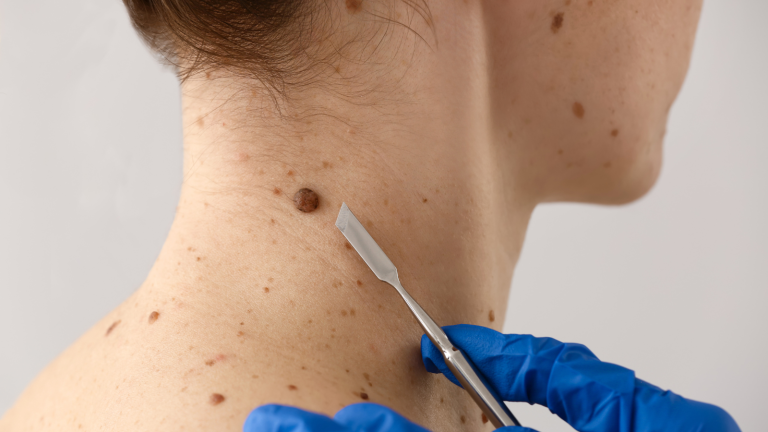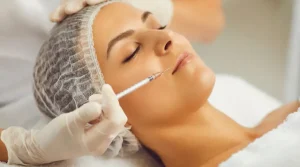Key Takeaways:
- The aberrant proliferation of skin cells is known as skin cancer. often caused by UV exposure.
- Melanoma, squamous cell carcinoma, and basal cell carcinoma are the three kinds of malignancy primary forms of skin cancer.
- Prevention includes sunscreen use, protective clothing, and avoiding peak sun hours.
- Early detection through regular skin checks can save lives.
- Treatments range from surgical removal to radiation and targeted therapies.
What Is Skin Cancer?
is a disease where abnormal skin cells grow uncontrollably. The primary cause is overexposure to ultravioletUV radiation from tanning beds or the sun, however genetics and other factors also play a role. There are several types of skin cancer, each with its characteristics and levels of severity.
How can you prevent it?
A: Prevent skin cancer by wearing sunscreen with SPF 30 or higher, avoiding peak sun hours, wearing protective clothing, and performing regular skin checks to detect early signs.
Reclaim Your Youthful Glow with Sculptra in Bergen County
Ready for a natural, long-lasting solution to facial volume loss? Book your consultation today and discover how Sculptra can help you achieve a rejuvenated appearance with minimal downtime. Schedule Your Consultation Now!
Types of Skin Cancer
Basal Cell Carcinoma (BCC):The most prevalent kind of skin cancer is BCC. often appearing as a waxy bump or flat lesion. It rarely spreads but can cause significant damage if left untreated.
Squamous Cell Carcinoma (SCC): The second most prevalent kind is SCC. and typically presents as a firm, red nodule or a scaly patch. It can become more aggressive and spread to other body parts if untreated.
Melanoma: The skin cancer form that is most lethal is melanoma. It begins in the melanocytes, the cells that produce pigment. Often, melanoma manifests as a changing-sized mole. color, or shape and can spread quickly to other organs if not detected early.
10 Common Causes and Risk Factors
- UV Radiation Exposure: Excessive sun exposure is the leading cause of skin cancer, especially during peak sun hours (10 a.m. to 4 p.m.).
- Tanning Beds: Artificial UV rays are as harmful as the sun and increase your risk.
- Fair Skin: People with lighter skin tones have less melanin, which increases their vulnerability to UV rays.
- Moles: A high number of moles or abnormal moles increase the risk of melanoma.
- Family History: An inherited susceptibility to skin cancer can elevate your risk.
- Weakened Immune System: Immune system-suppressive conditions can make you more vulnerable.
- Age: Senior citizens are more vulnerable because of cumulative sun exposure.
- Frequent Sunburns: Having a history of sunburns, especially in childhood, raises your lifetime risk.
- Living in Sunny or High-Altitude Climates: More intense sun exposure increases the chance of skin damage.
- Exposure to Certain Chemicals: Long-term contact with substances like arsenic or coal tar can increase cancer risk.
Unlock the secret to youthful, radiant skin! Learn how collagen plays a key role in maintaining firmness, elasticity, and a glowing complexion
Prevention and Early Detection
Prevention is your best defense against skin cancer. Follow these tips to minimize your risk:
- Sunscreen Use: Apply broad-spectrum sunscreen with at least SPF 30 daily, even on cloudy days. Reapply every two hours when outdoors or after swimming or sweating.
- Protective Clothing: Wear long-sleeved shirts, wide-brimmed caps together with sunglasses to shield your skin from UV rays.
- Avoid Peak Sun Hours: Stay indoors or seek shade between 10 a.m. and 4 p.m., when UV rays are strongest.
- Regular Skin Checks: Perform monthly self-exams to look for new growths or changes in moles, and visit a dermatologist for yearly professional skin checks.
Treatment Options For Skin Cancer
The kind, size, location, and stage of skin cancer all influence the course of treatment. Common treatment methods include:
- Surgical Removal: Removing the tumor and some surrounding tissue is the most common treatment for skin cancer.
- Radiation Therapy: High-energy rays target and destroy cancer cells.
- Topical Medications: Creams and ointments can be used for certain skin cancers, particularly superficial ones.
- Cryotherapy: Freezing cancer cells with liquid nitrogen can be effective for early-stage skin cancers.
- Mohs Surgery: This precise technique removes thin layers of skin, which are examined for cancer cells, ensuring minimal damage to healthy tissue.
- Targeted Therapy and Immunotherapy: Used primarily for advanced melanoma, these treatments work by attacking specific cancer cells or boosting the immune system.
The Importance of Sunscreen
Sunscreen is an essential tool in skin cancer prevention. Seek for a sunscreen with broad-spectrum protection from UVA to UVB radiation. Dermatologists advise using at least 30 SPF for daily use and SPF 50 or higher for extended outdoor activities. Regularly reapply, particularly after perspiring or swimming, to guarantee continued protection.
Conclusion
One of the most prevalent forms of cancer is skin cancer, yet it is also extremely preventable. By incorporating sun-safe practices like wearing sunscreen, protective clothing, and scheduling regular skin checks, you can significantly reduce your risk. Early detection is key to successful treatment, so Don’t wait to get medical help if you see any changes in your skin. Protect your skin today to ensure a healthier tomorrow.





